
Scotching the Myth

In suspected cat attacks, some "experts" measure the distance between two puncture marks and compare this measurement to the distance between the upper or lower canines (see photo above) of various cat species. Ben Willis demonstrates that both upper-canines will rarely penetrate the flesh and in fact, two puncture marks generally represent one upper and one lower canine.
Cat and dog bites
By Ben Willis
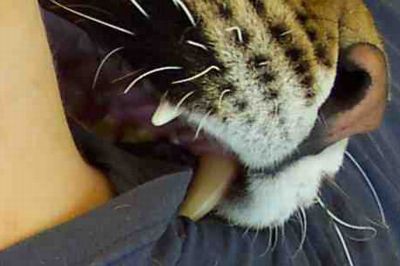
Since the early 1980s when sheep and other farm animals were suddenly reported as being slaughtered and mutilated by a cat-like beast in the area of Devon and Exmoor, researchers of the phenomena have sought to determine the type animal responsible. In some cases, the culprit had reportedly ripped the throats of its victims, in other cases, the sheep were left alive yet partially disemboweled. There were numerous cases of horse attacks and what appeared to be the signs of a large cat. After a big cat was suspected, numerous researchers began finding deer in several areas which also appeared to be the work of a predatory feline.
In viewing many photographs of the purported attacks and carcasses, I'm reasonably certain that a large cat was in fact responsible for at least two of the deer-kills, and multiple injuries to one horse. The majority of the others are either too mutilated to make any determination, and others are completely inconsistent with the predatory habits of any large cat. In my opinion, the animals which appeared to have been savagely ripped open showed the work of dogs. While various species of cats employ different killing techniques, no feline inflicts damage in this fashion. Both the teeth and claws of the leopard and puma are much too fragile for this rigorous tearing of flesh. The canine teeth of felines are designed as puncturing devices. Unlike the dog who grasps the hide of an animal, then begins the ripping by utilizing his own weight and strength, the feline employs a much different method. Instead, the cat will secure himself to large prey by the use of his claws. The dew-claw, or fifth claw acts as an anchor while the cat is able move upward with the remaining claws which act independently. Once the head is reached, the cat may either puncture the skull at the base of the spine, or the animal is suffocated as the cat restricts breathing in crushing the windpipe. Either way, the teeth are cautiously protected and the cat takes little risk in causing them damage.
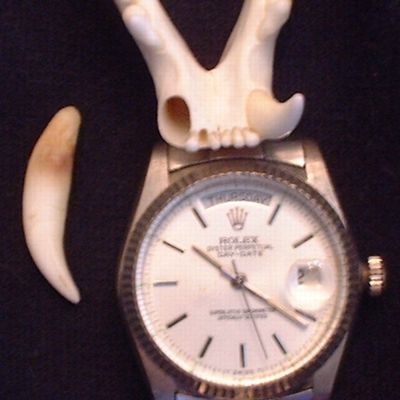
The mandible of a wild cat in this photograph illustrates the shallow root-system of the feline canine fangs. Exceptionally strong in vertical punctures, these teeth are much too delicate for horizontal ripping.

In this image, the cat playfully demonstrates how the claws are firmly attached prior initiating a bite. The fifth claw is securely anchored as the cat prepares to insert the canines. In analyzing animal bite-marks, there is a much different approach than forensic examination of human bites on victims. One of the earliest forensic examination of human bite-marks occurred in 1979 with the Florida trial of serial-killer Theodore Bundy. Bundy's own teeth were imprinted and matched against marks left on the flesh of a murder victim. The marks were a perfect match causing Bundy's conviction and ultimately his execution in 1989.
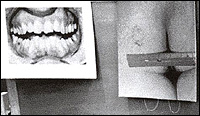
Animal bites of both candid and feline leave much different imprints than those of human teeth. Often, experts will measure the two punctures in the mistaken belief that it will determine the distance between the canines. In actuality, both upper-canines will rarely penetrate the flesh, instead two punctures represent one upper and one lower canine. The relative distance between the two punctures is basically academic in determining any bite radius. The images below demonstrate the method that the three cats employ in inflicting bites.
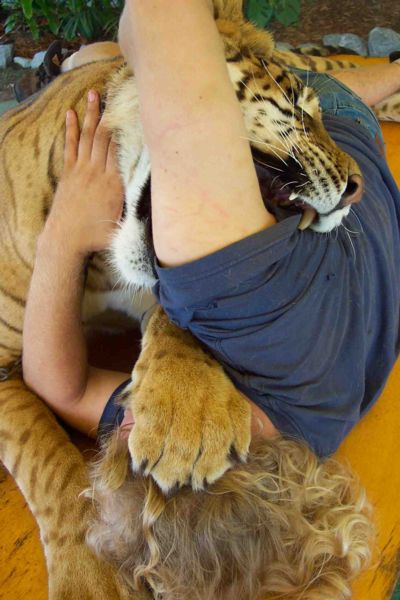
The following image shows the bite-marks of a bobcat in the upper leg of a dog. The two punctures are entered in opposite angles indicating the upper and lower canines while the other two never penetrated the flesh.

Dogs and cats with exceptionally powerful jaws, such as the pit-bull may cause a bite to the body of a small animal, or the extremity of a large one. So powerful are these jaws, they may sometimes cause the flesh to rip open in the same manner as an over-inflated automobile tire. Recently, in the state of Utah there began a rash of cat killings believed to be the work of a psychopath intent on torturing and mutilating pet felines. Domestic cats were found in residential areas having been killed in what appeared to be a most bizarre fashion. Long lacerations were found on the carcasses which appeared to have been done with a scalpel, and with exact precision. After an extensive investigation, these cuts were viewed through a microscope and it was determined that the wounds were in fact ripping lacerations caused by animals.
The following photos show a leg-wound caused by the single bite of a forty pound pit-bull. The first image was made shortly after the incident, the second was ten days later after the stitches were removed and the swelling improved. Here, the marks reveal that the right canine penetrated the flesh extremely deep, while the left barely broke the skin. The long gaping wound is the result of the tearing and pressure applied below and to the left. Neither of the dog's teeth touched this area. The third image shows the backside of the injured leg and imprints of the dog's lower teeth are clearly visible. These type bites where the marks could be matched with the animal are extremely rare.
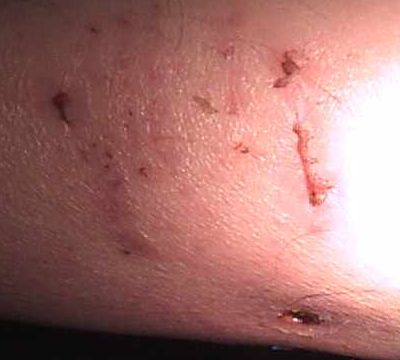
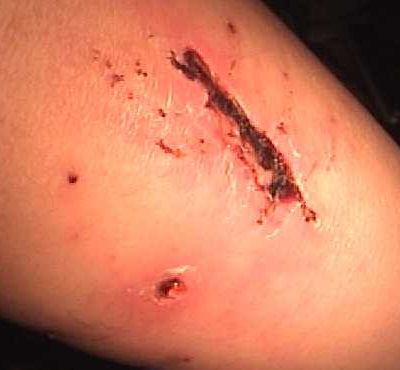

The following photo shows a similar bite where a bobcat sustained a leg bite from a large rottweiler. The extreme bite pressure caused a wound similar to the human leg as the flesh literally burst open.
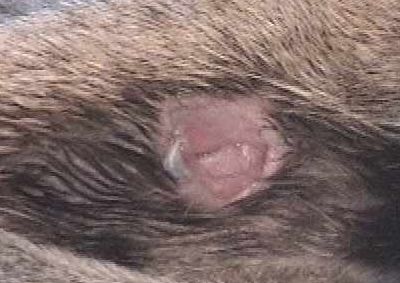
The following photo shows a more typical dog-bite as the scar-tissue shows only two punctures, the upper and lower canines of a Doberman-pinscher.

In summary, ripping bites cannot be attributed to cats, large or small. These wounds are almost always perpetrated by dogs, and most commonly large dogs. Felines of all species puncture with the teeth and claws, but these punctures can rarely be matched to any pattern in identifying a specific animal. Ripped flesh and gaping wounds represent the methodical killing technique of dogs. When such wounds are caused by the feline, it should be considered a failed attempt which is extremely rare with the calculating feline.
Additional information
By Aron Bowers
ery informative, and I agreeable generally. A 'side-on' attack by carnivore, may well show 2 lacerations/punctures on the prey item, but, as stated, this demonstrated by 2 punctures with different angles of penetration re canine teeth.
The only attacks I've seen have been on cats and dogs, domestic type that is. (I haven't included the sheep kill I discovered @ Loch ness, later)
Dogs on attacking, by virtue of their mode of attack, and prey pulling away-struggling, prey species generally exhibit tags of skin/connective tissues hanging loose, (or missing in my case, when bitten by G/Shepherd)
Cats attacking cats do show both upper canines often, and if this is associated with biting a limb, often lower canines show distinct punctures to the skin. (Upper canines generally shown on lateral aspects of limbs, lower canines (with considerably smaller inter-canine gap) on medial aspects of limb.
Cats fighting, and biting faces- I do occasionally see side-on, lateral mode of attack, with upper and lower canine marks/punctures
from the same side shown, but again, as stated by Ben, the directions
of the puncture marks reveal the mode of attack.
With reference to predated animals, be they alive or dead, the diretions of the punctures can be appreciated by probing the holes
with blunt probes, to ascertain the mode of attack.
 |
 |
 |
| Return to index | Return to Scottish Big Cats | Return to Identification |